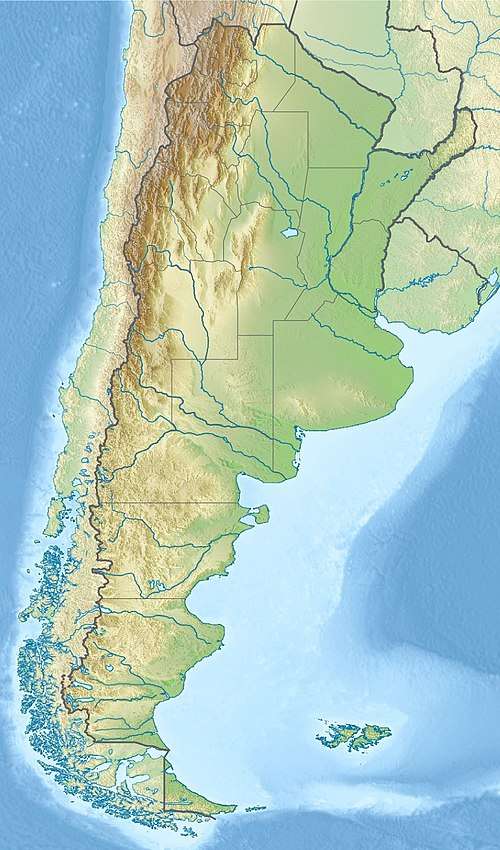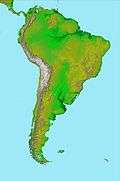Salta Basin
| Salta Basin | |
|---|---|
| Cuenca Salta | |
 Location of the basin in Argentina | |
| Coordinates | 23°40′S 66°07′W / 23.667°S 66.117°W |
| Etymology | Salta Province |
| Region | Argentine Northwest |
| Country |
|
| State(s) |
Salta, Tucumán Cochabamba Antofagasta |
| Cities | Salta |
| Characteristics | |
| On/Offshore | Onshore |
| Boundaries | Andes |
| Part of | Andean foreland basins |
| Geology | |
| Basin type |
Foreland-on-rift basin or intracontinental rift basin |
| Plate | South American |
| Orogeny | Andean |
| Age | Neocomian-Neogene |
| Stratigraphy | Stratigraphy |
Salta Basin or Salta Rift Basin is a sedimentary basin located in the Argentine Northwest.[1][2] The basin started to accumulate sediments in the Early Cretaceous (Neocomian) and at present it has sedimentary deposits reaching thicknesses of 5,000 metres (16,000 ft). The basin contains seven sub-basins: Tres Cruces, Lomas de Olmedo, Metán, Alemanía, Salfity, El Rey, Sey and Brealito. The basin environment has variously been described as a "foreland rift" and an "intra-continental rift". The basin developed under conditions of extensional tectonics and rift-associated volcanism.[1]
Description
The basin basement is composed of rocks belonging to the Puncoviscana Formation.[2] The volcanism that began in the Late Jurassic was initially of subalkaline character (low sodium and potassium content), but turned increasingly alkaline in the Early Cretaceous.[1]
The rifts of Salta Basin developed in a time of generalized extensional tectonics along western South America.[3] It has been proposed that the Salar de Atacama depression in Chile was once a westward rift arm of the Salta Basin.[4]
Stratigraphy
- Neogene
- San Felipe Formation
- Piquete Formation (Huayquerian)
- Guanaco Formation
- Palo Pintado Formation (Chasicoan to Montehermosan)
- Angastaco Formation
- Anta Formation
- Jesús María Formation
- Paleogene
- Los Colorados Formation
- Salta Group
- Lumbrera Formation (Casamayoran)
- Quebrada de los Colorados Formation (Casamayoran)
- Maíz Gordo Formation (Itaboraian to Casamayoran)
- Mealla Formation (Itaboraian)
- Tunal Formation
- Olmedo Formation
- Yacoraite Formation (Maastrichtian to Danian)
- Lecho Formation (Early Maastrichtian)
- Los Blanquitos Formation (Campanian)
- Los Curtiembres Formation
- La Yesera Formation
References
- 1 2 3 Marquillas, Rosa A.; del Papa, Cecilia; Sabino, Ignacio F. (2005). "Sedimentary aspects and paleoenvironmental evolution of a rift basin: Salta Group (Cretaceous–Paleogene), northwestern Argentina" (PDF). International Journal of Earth Sciences. Springer-Verlag. 94: 94–113. Retrieved 12 December 2015.
- 1 2 Grier, M.E.; Salfity, J.A.; Allmendingern, R.W. (1991). "Andean reactivation of the Cretaceous Salta rift, northwestern Argentina" (PDF). Journal of South American Earth Sciences. Pergamon Press. 4 (4): 351–372. Retrieved 13 December 2015.
- ↑ Ramos, Víctor A (2009). "Anatomy and global context of the Andes: Main geologic features and the Andean orogenic cycle". The Geological Society of America Memoir. 204: 31–65. Retrieved 15 December 2015.
- ↑ Reutter, Klaus-J.; Charrier, Reynaldo; Götze, Hans-J.; Schurr, Bernd; Wigger, Peter; Scheuber, Ekkehard; Giese, Peter; Reuther, Claus-Dieter; Schmidt, Sabine; Rietbrock, Andreas; Chong, Guillermo; Belmonte-Pool, Arturo (2006). "The Salar de Atacama Basin: a Subsiding Block within the Western Edge of the Altiplano-Puna Plateau". In Oncken, Onno; Chong, Guillermo; Franz, Gerhard; Giese, Peter; Götze, Hans-Jürgen; Ramos, Víctor A.; Strecker, Manfred R.; Wigger, Peter. The Andes: Active Subduction Orogeny. p. 303–325. ISBN 3-540-24329-1.
Bibliography
- Del Papa, Cecilia E. 2006. Estratigrafía y paleoambientes de la Formación Lumbrera, Grupo Salta, Noroeste argentino. Revista de la Asociación Geológica Argentina 61. 313-327. Accessed 2017-08-15.
Further reading
- Moreno, Teresa, and Wes Gibbons. 2006. Geology of Chile, 1–396. Geological Society of London. Accessed 2018-09-06. ISBN 9781862392199
